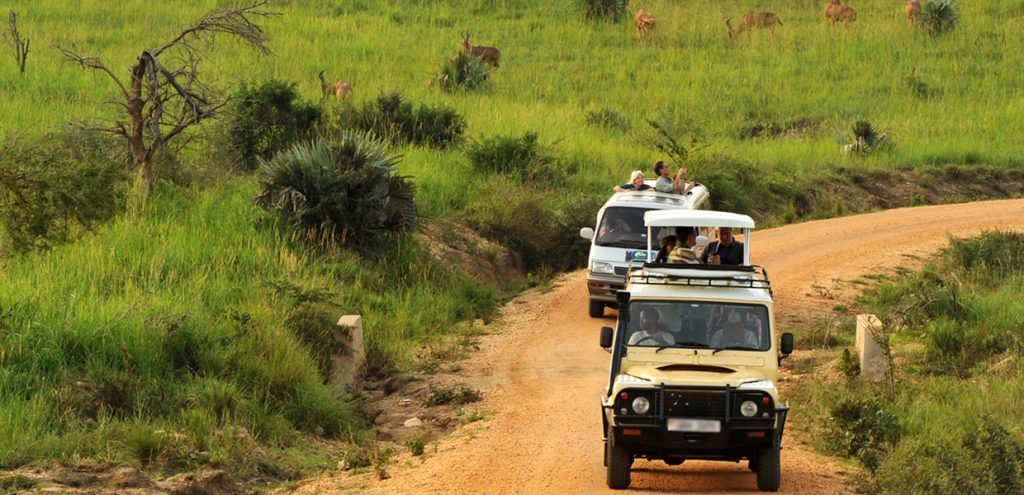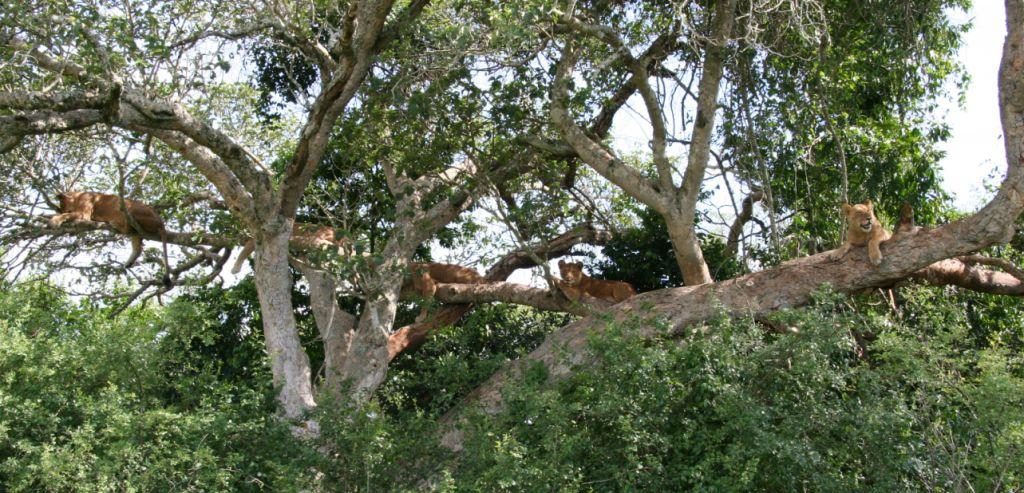A game drive in Queen Elizabeth National Park is very interesting and memorable, and best done very early in the morning or late afternoon hours. There are well-maintained tracks, which give visitors access to all park’s big game. The tracks pass through the mating grounds of the great Uganda Kob. While here, the allegorical giant forest hogs can also be seen moving around the bush as you watch the big five including the lions hunting for prey.

On hot days, giant African elephants can be seen making their way down to water streams while bushbucks and buffaloes can be found on the channel track. The outstanding panorama along the crater track brings you to volcanic craters at the foothills of the misty ‘mountains of the moon’, (Rwenzori Mountains). As a result, it is very inspiring to take a game drive in Queen Elizabeth National Park as you get to view all the remarkable wildlife in close proximity.
The 1,978km² wide national park is one of the most amazing parks for a safari game drive. Your game drives through this park will be one of a kind in your lifetime. Queen Elizabeth National Park has a stretch of over 200km of road track that can help you do your safari game, until you get exhausted of viewing diverse wildlife.
Game Drive in Queen Elizabeth National Park can be split into three sectors; the Channel Drive Circuit, Kasenyi Plains, and the Ishasha plain sector.
Game Drive in Ishasha Sector – Part of Queen Elizabeth

Queen Elizabeth has unbelievable attractions, but Ishasha sector never fails to come up with more surprises, which is why it is the true jewel of the southern pearl of this park. While in this areas, you will see the famous Ishasha tree-climbing lions, which are extremely special, very healthy, and numerous. One of the prides you are likely to see is the Kyemale pride on the large fig tree. See the topi, Uganda kob, and buffaloes graze in the acacia-studded savannah among other wildlife, together with very unique countless bird species.
The endless Ishasha side which is located in the southern part of the park, is roughly 100km long, that’s about a 2 hours drive from the park headquarters, well known for the tree-climbing lions which do hide in the plain fig trees.
Ishasha border point is a border crossing station and customs post in Kanungu district in western Uganda. It is inset 350 meters from the Ishasha River, which marks the Uganda – Democratic Republic of Congo (DRC) border. That is about 1.3 kilometers from the town of Ishasha across the river in the DRC. The border point is a designated end of the Rukungiri–Kihihi–Ishasha–Kanungu road, which partially forms the boundary of the Ishasha Sector of Queen Elizabeth National Park. It is also on the boundary of Virunga National Park in the DRC.
Ishasha sector offers the most amazing sights while on a game drive in Queen Elizabeth National Park – something that you cannot find in all of Africa, except sporadically at Lake Manyara in Kenya. Besides tree climbing lions, you will come across a variety of wildlife during your time in Ishasha such as giant savannah African elephants, buffalo herds, and countless antelopes.
More About Ishasha Sector
The tree climbing lions climb sycamore fig trees and acacia trees, although sycamore fig trees are their most preferred choice. Ishasha is the most reliable location in East Africa to spot these lions sleeping the whole day away in these trees. On your lucky day, you can find more than 10 lions, including males, females and cubs, all piled up on one fig tree, just resting and watching over, during day time. This will make up your entire dream trip, as a satisfaction to your entire African adventure.
You can opt to visit the Ishasha plains as you’re heading to Bwindi Impenetrable for an amazing gorilla tracking experience, as you move out of the park, or as you’re coming from Bwindi for a game drive in Queen Elizabeth National Park. It is a breathtaking sight to behold the ‘King of the Jungle’ perched up high on one of the branches of the huge fig trees in this area, lazily resting away as the day goes by. The Ishasha is certainly one of the most memorable destinations in Africa.
Game Drive in Channel Drive Circuit – Part of Queen Elizabeth
The Channel Drive Circuit follows close to the northern shore of Kazinga Channel, with roads that wind between tangled thickets interspersed with cactus-like euphorbia trees. The most common large mammals seen here are elephants, hippos, warthogs, bushbucks, waterbucks, and frequently lions.
Leopards are also a common sight in this section of the park, however, on a rare scale. A game drive in this section provides a rare opportunity to get up close and personal with this magnificent wild cat though they are too shy and always hide away from humans.
You can trace the leopards on the leopard loop circuit which is a common place for sighitng them. This is also one of the few places in Africa where the rare giant forest hog is regularly seen during daylight hours.
For those interested in birding in Queen Elizabeth, this section of the park has it all, since it has a lot to offer. Woodland birds and water birds that may have come for roasting and feeding can easily be found here. Many kobs can be seen at the kob circuit as you are heading to Katungulu gate. This will also give you a chance to see waterbucks as well since it is more of a savannah open area. Other sub circuits around include the Royal circuits.
Kasenyi Plains – Part of Queen Elizabeth
The Kasenyi Plains stretching towards Lake George is a typical African savannah plain with undulating grasslands. These rolling plains support some of the largest concentrations of the game anywhere in Queen Elizabeth National Park while offering a different selection of animals than what can be seen on the Channel Drive Circuit, which is more of a savanna woodland.
This section of the park is also known for sighting lions as they normally feed in this section of the park. Alongside wonderful variety of game and predator species, this section of the park also boasts of an interesting selection of grassland bird species, including grey-crowned crane, red-throated spurfowl, and yellow-throated longclaw among others.
